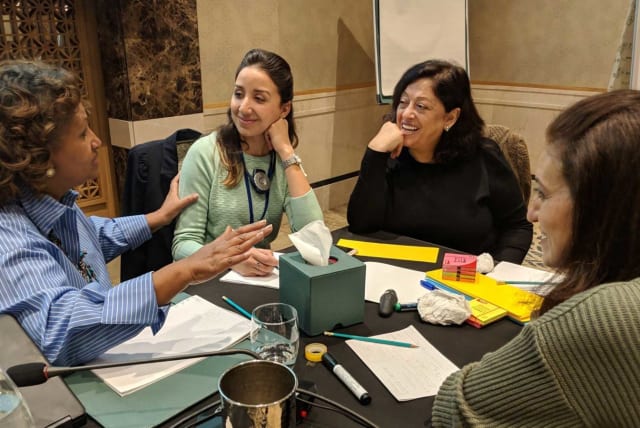More women secure senior positions in UAE, Egypt, as MENA region struggles with gender gap

According to the 2023 edition of the Global Gender Gap Report, the MENA region remains the furthest away from gender parity compared to other regions.
Emirati journalist Ameera Alawadhi is an achiever despite the numerous challenges faced by women in the Middle East and North Africa (MENA) region today.
As International Women’s Day marked its 49th anniversary last week, many countries in the region were still showing little to no progress compared to 2022.
“I consider myself a self-made entrepreneur who has faced many challenges along the way,” Alawadhi tells The Media Line, “from family and peers’ judgment of my social media activities promoting the brands I work with to online hate for my ‘nontraditional’ appearance as an Emirati woman on platforms like Instagram and TikTok.”
According to the 2023 edition of the Global Gender Gap Report, the MENA region remains the furthest away from gender parity compared to other regions, with a 62.6% parity score. This represents a 0.9 percentage-point decline in parity since 2022. This decline was an expected outcome of the post-pandemic crisis that affected the workforce. Gender parity across key indicators was slipping, indicating a large-scale disruption of economic opportunities for women worldwide in labor-market participation and overall well-being, as noted by the World Economic Forum in 2022.
The MENA region achieves 95.9% parity on the Educational Attainment subindex, with Israel being the only country to have full parity. Concerning political empowerment, three countries have made progress in 2023: Bahrain, Qatar, and Kuwait. Only Tunisia, Bahrain, and Morocco have cabinets in which more than 20% of the ministers are women, while Saudi Arabia and Lebanon still maintain all-male cabinets. Apart from Tunisia and Israel, no country in the region has had a female head of government in the last 50 years.
Economic opportunities for women
In terms of economic participation and opportunity, the gender gap has closed by 44%, with both the UAE and Egypt seeing increases in the share of women in senior officer positions and technical roles.
The Egyptian government, in collaboration with the National Council for Women, has adopted the Women’s Vision 2030. This initiative aims to expand partnerships to achieve a national strategy for empowering Egyptian women by 2030, in alignment with Egypt’s constitution, the country’s Vision 2030, and the Global 2030 Agenda for Sustainable Development.
Constitutionally mandated gender quotas in Egypt guarantee that women will hold at least 25% of the seats on local councils and in the lower house of parliament, while 10% of seats in the Senate are set aside for women. Women are underrepresented on company boards of directors, with Women’s Vision 2030 aiming to achieve at least 30% female membership on boards.
Hibaaq Osman, a Somali activist and the founder of the Think Tank for Arab Women, the Dignity Fund, Karama, and the Center for Strategic Initiatives of Women, highlights Egypt’s progress, telling The Media Line: “Egypt is doing better than in the past, and there is a clear awareness that hiring women and improving gender parity by at least 25% would increase the global GDP and shape a different future for the country and its women.”
Despite these efforts, inequality persists, especially in rural areas, as she further explains: “I decided to create Karama to assist women in rural areas facing issues such as school restrictions, early marriages, and societal norms that hinder women from working and entering the public sphere. Even with the best constitution and legal system in any Arab country, spreading awareness within rural communities remains challenging because women may not be aware of their rights.”
She also addresses the role of governments in Egypt and Jordan: “There are ongoing discussions within the governments … to reform and improve women’s rights. Yet, a definitive plan from a woman’s perspective is notably absent. This absence may hinder progress in terms of gender-based violence, access to health care, and knowledge about reproductive rights. The path ahead is long, especially as women in rural areas face more challenges related to societal norms compared to those in urban areas.”
Are Arab societies evolving in terms of gender equality?
“Each country in the MENA region has adopted its own laws to increase women’s visibility, but there are still ways of disempowering them,” she continues. “For example, in elections, women are sometimes not placed at the forefront of a political party’s list to prevent their election. This is why we have few women presidents and examples of women in high-ranking positions. Arab societies are evolving, but this change will take time. The key question is whether governments are making sufficient efforts. A piece of paper is not enough; implementing laws in both rural and urban areas is crucial.”
The United Arab Emirates overtook Israel as the highest-ranking Middle Eastern country on the 2023 Global Gender Gap Index, ranking as 71st among 146 countries, with a parity score of 0.712 out of 1. The UAE also beat out some European countries, such as Greece, Hungary, Italy, and Romania. Israel fell from 60th place in the 2022 report to 83rd in 2023.
The UAE plays a crucial role in women’s employment and empowerment, as noted by Alawadhi: “The UAE government is supportive; we have free college education, unemployment benefits, and numerous government programs for women. The cost of a business license for women is also lower.”
2023 was a challenging year for women in the region, with a shocking level of gender-based violence during the Israel-Hamas war and the Sudanese civil war. Additionally, many women were arrested, beaten, shot, and killed for protesting in Iran.
Looking ahead to 2024, gender-related issues must be a central theme in the MENA region to achieve better outcomes and overcome obstacles, aligning with the goals of the Gender Responsive Just Transition & Climate Action Partnership of COP28. This would create more opportunities for women, especially those affected by the climate crisis.
Faria Nasruddin, project lead for the Middle East Women's Initiative at the Washington-based Wilson Center think tank, told The Media Line that high levels of educational participation for women in the Middle East don’t necessarily translate into workforce participation. She said a chief obstacle was educational curricula not connected to workplace skills.
“On top of that, despite government reforms and laws to increase women’s access to the workforce, this has not been translated into implementation mechanisms,” she said. “Moreover, other barriers are related to access to safe and accessible transportation, proper access to digital tools, and sociocultural norms and gender-based stereotypes portraying women as incapable of certain roles.”
Jerusalem Post Store
`; document.getElementById("linkPremium").innerHTML = cont; var divWithLink = document.getElementById("premium-link"); if (divWithLink !== null && divWithLink !== 'undefined') { divWithLink.style.border = "solid 1px #cb0f3e"; divWithLink.style.textAlign = "center"; divWithLink.style.marginBottom = "15px"; divWithLink.style.marginTop = "15px"; divWithLink.style.width = "100%"; divWithLink.style.backgroundColor = "#122952"; divWithLink.style.color = "#ffffff"; divWithLink.style.lineHeight = "1.5"; } } (function (v, i) { });

